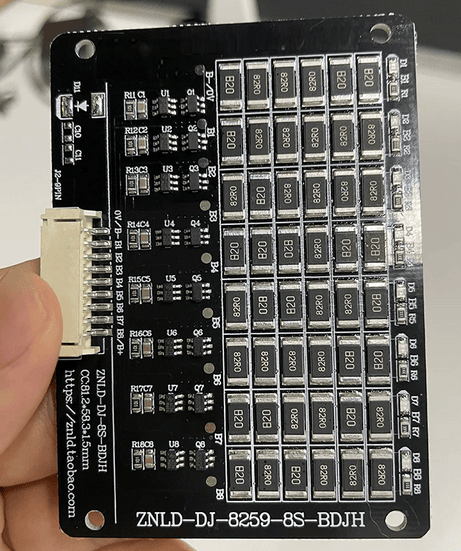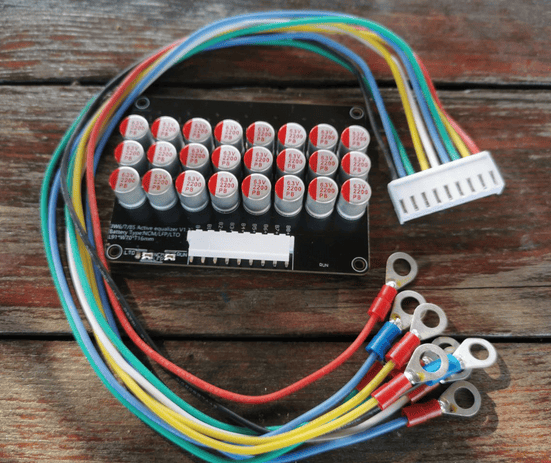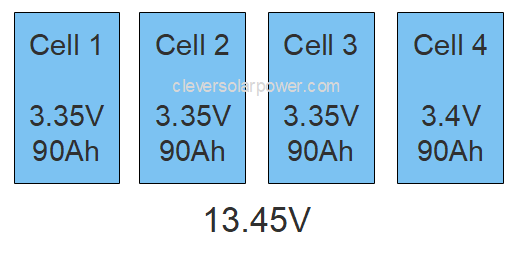Balancing the cells is crucial when it comes to maintaining the performance and longevity of LiFePO4 battery packs. But did you know there are different methods for balancing and that the balancing process involves more than just voltage readings?
In this comprehensive guide, we’ll explore the ins and outs of active and passive balancing, address common questions, and reveal some lesser-known aspects of the balancing process.
Keep reading to uncover LiFePO4 cell balancing and learn how to get the most out of your battery system.
Passive balancing
In passive balancing, also known as “bleed balancing,” excess charge from the more charged cells is dissipated as heat through external resistors. This method is relatively simple and cost-effective, but it can be less efficient as the energy is wasted as heat.
Passive balancing is typically used in smaller battery systems or when energy efficiency is not a primary concern.

Pros
- Simpler and more cost-effective
- Suitable for smaller battery systems or when energy efficiency is not a primary concern
Cons
- Less energy-efficient as energy is wasted as heat
- Slower balancing process

Active balancing
Active balancing, on the other hand, involves redistributing excess charge from the more charged cells to the less charged cells. This method uses specialized circuits and components to transfer energy between cells without dissipating it as heat.
Active balancing is more complex and more expensive, but it offers higher energy efficiency and faster balancing because of the higher current. It is often used in larger or more sophisticated battery systems where energy efficiency is crucial.

Pros
- Higher energy efficiency
- Faster balancing process
- Suitable for larger or more sophisticated battery systems
Cons
- More complex and expensive

FAQ
When should you balance LiFePO4 cells?
Balancing should be done whenever a significant difference in cell voltages is observed. Regular monitoring of cell voltages is recommended to ensure optimal battery performance.
If you have a BMS, they will already come with a balancer. Most of the time this is a low current balancer. Read my article on the best BMS to find out their balancing current.
You should try without an external balancer first. If the BMS cannot balance your cells, then you can use an external balancer.
Do you need a balancer?
Yes, a balancer is required to ensure that all cells maintain equal charge levels. Balancers can be active or passive, depending on the specific needs of your battery system, only if your BMS cannot handle the charge difference.
How much current do you need for balancing?
The required current for balancing depends on the capacity of the cells and the size of the battery pack. Generally, a higher balancing current is needed for larger battery packs and cells with higher capacities.
The requirements will be different if you have 280Ah cells or 20Ah cells. I recommend using 5A if you use 280Ah cells and your BMS cannot handle the balancing itself.
If you have a 5A active balancer, then in normal conditions, it will never reach those 5amps. A more realistic current will be 1amp when the cells do not differ as much. 5A is only possible when one cell is empty while the others are full. Watch this video for a demonstration.
Does balancing work with the voltage reading of the battery cell?
Yes, balancing works by monitoring and adjusting the voltage of individual cells to ensure they all have equal charge levels. The voltage will drop because the balancer discharges the cell and charges the other cells with the current.

Can you group different cells?
It is not recommended to group different cells together, as differences in capacity, age, or chemistry can lead to imbalanced charging and discharging, reducing overall battery performance and lifespan.
Grouping different cells is done with lithium 18650 battery cells because having every cell wired to a balancer is not economical. Here, several cells are added in parallel.

However, for large lithium cells, every cell should have a connection to a balancer.
Do cells get re-balanced during charging or discharging?
When the battery is hovering between 10% and 90%, the balancer will not balance. This is because the voltage difference will be very low because the charge and discharge voltage curve of LiFePO4 is very flat.
To see a voltage difference, the battery should be charged to 100%. Then the balancer will become active and start balancing the cells.
What is the difference between equalizing and balancing?
Equalizing is a process in which all cells in a battery pack are charged to the same voltage, while balancing ensures that all cells maintain equal charge levels throughout the charging and discharging cycles.
What is top and bottom balancing?
Top balancing ensures that all cells are fully charged at the same voltage, while bottom balancing ensures that all cells are discharged to the same voltage. Top balancing is more common, but bottom balancing can be useful for applications requiring deep discharging.
Do you still need a BMS when you have an active balancer?
That’s a question where we can debate over for a long time. Generally, because of safety reasons, I will recommend getting a BMS. If you have trouble sleeping with only an active balancer connected, I recommend getting a BMS 😉
Do I advise adding an active balancer to your system?
I do not advice adding one initially. If your battery get’s unbalanced during use and the BMS can’t keep up, you can add an active balancer.
If you do get one, I recommend getting one that you can turn on and off. The balancing is effective when your cells reach 3.42V because that’s when the voltage difference will be the highest.
Conclusion
Understanding the differences between active and passive balancing of LiFePO4 cells and when to use each method is crucial for maintaining optimal battery performance and lifespan. By carefully considering your battery system’s needs and monitoring cell voltages, you can ensure that your LiFePO4 cells remain balanced and deliver reliable power for your application.
[custom-related-posts title=”Related Posts” none_text=”None found” order_by=”title” order=”ASC”]
I’m an off-grid enthusiast. I created this website to give clear and straight-to-the-point advice about solar power. I’m also the author of the book ‘Off-grid solar power simplified‘. Read more about me on my about page, check out my Youtube channel, or send me a message.
With an automatic active balancer, do all the wires have to be the same length? Here are details of my setup – the active balancer I’m installing: ‘Heltecbms 6A Hybrid Active Equalization’
This type of active balancer is quite typical.
I’m adding a relay circuit to it so it will only start balancing my 16s LiFePO4 batteries when the pack voltage reaches 54.72 volts, which is 3.42 volts per cell (16 x 3.42 = 54.72).
The active balancer will install in my battery pack better if I lengthen some of the wires, to connect to the cells that are farther away from the balancer. For all of the balancer wires, I’m using 16 awg wires instead of the thinner (approx 20 ga?) wires it came with. These are the thickest wires that will still fit into the screw-terminal connector for the active balancer.
Since I’m installing new wires, can I make each wire the actual distance from each cell to the balancer? For instance, some wires would be 6 inches long, some would be 33 inches long, and others would be in between these lengths.
In particular, has anyone (or you) done this and compared the result with keeping all the balancer wires the same length?
And, in case you are wondering, I am also using a BMS that does not have active balancing.
Thank you for your help and attention.
Yes, you have to make the wires the same length. otherwise different voltage will be measured due to voltage drop. Off-grid garage on youtube has a nice setup where he has terminal blocks mounted on a din rail and then new wires with the same length go to the individual cells.